Dodge M37
 3⁄4-ton 4x4 truck 115,838 1951-68.
3⁄4-ton 4x4 truck 115,838 1951-68.
The Dodge M37 wwas noted as a "3⁄4-ton 4x4 truck, M37" in the inventory. It was developed as a successor to the popular mass-produced Dodge WC Series of World War II. Entering service 1951, it wa declined in many configurations and derivatived, seeing combat on the frontline both in the Korean War and Vietnam wars, before being replaced by two commercial off the shelf vehicles, the Kaiser M715 (1967) and Dodge M880/M890 series (1975). Dogge internal model designation was G741. Phased out in the 1970s in the US, they were auctioned via a Gvt. agency the to civilian market while also see service in foreign militaries for decades.
Development
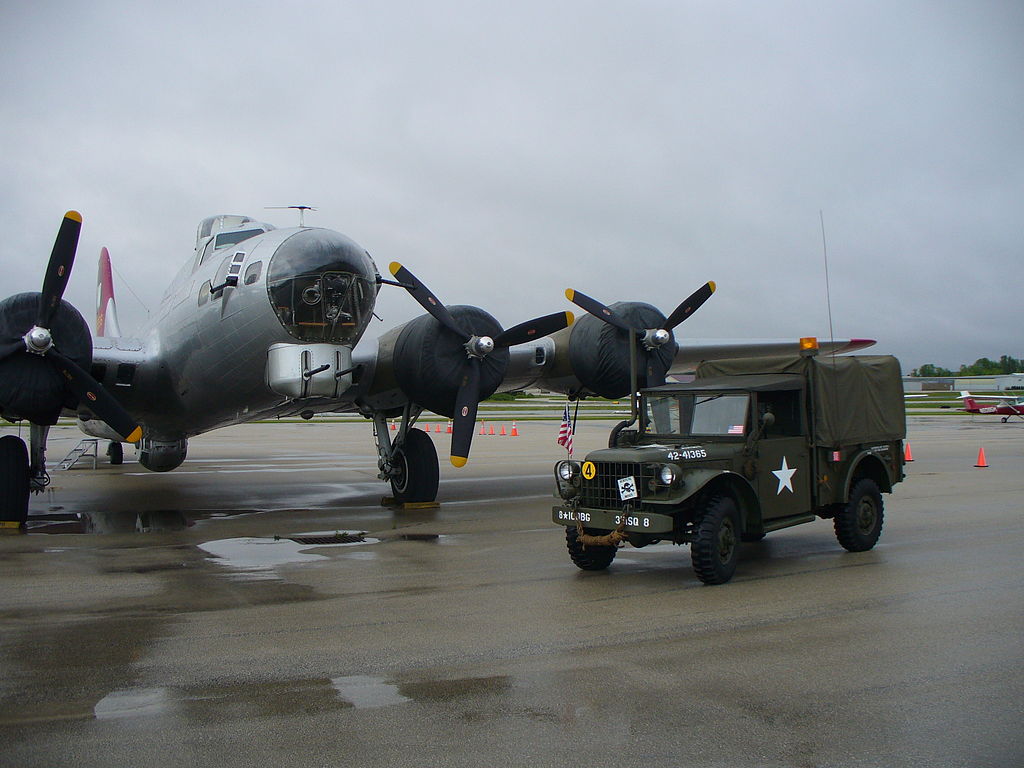 M37 at a historical flight air show, close to a B17
M37 at a historical flight air show, close to a B17
In 1948, the Army needed to replace the Dodge WC series, a sturdy famliy that was now showing its age, in addition of being worn out after WW2 service on all fronts. The replacement was to fill the gap between the Jeep and the bigger trucks. The first prototypes by Dodge, which was the best placed to succeed its own model, arrived to be tested in 1950. This led to specifications for the final design in 1951. It was soon standardized as the M37. Externally they looked like slighty beefier, more refined WC series, but this ws eentially the same vehicle in any ways. The first batches (the production went on until 1968) saw action in the Korean War, but later they replaced old WCs already adopted many many foreign militaries all over the world.
The "great sellout" to the civilian market started in 1978. This enabled a brand new career over decades and it's still cherished by collectioners and reenactors today as remarkably close to the WW2 Dodge WC. M37’s were also used by public and regional services such as fire departments, forestry departments, city parks departments. Their rugged nature, easy of repair and solid 4x4 capabilities still made them a treasured item in outdoor.
 Original Tech booklet
Original Tech booklet
Many components on the M37 insdeed were similar or identical to the Dodge WC series in order to reuse the well-provided pre-sexisting logistic chain in 1950 maintained for the WC already. Dodge used 1948-1950 to iron out many deficiencies of the WC. A conventional pickup truck style bed replaced the WC mulirole platform for easier production. Drivetrain and powerplant commonalit rested on the WDX series civilian Power Wagons, but the body was completely new however. Six WC-based prototype W37s were delivered to be tested in February to March 1950, first pre-production pilot vehicles were out of Dodge factory floor on 14 December. Accepted by the Army, a contract was signed in January 1951. In total orders would pile up to reach 115,000 vehicles produced until 1968.
In December 1951 alone, 11,000 vehicles were delivered, and by mid-1954 63,000. In 1958 modifications to the design led to the new standard M37B1. From mid-1958 until 1968, 47,600 M37B1 were produced on top of the base model. Dodge Canada also joined the production and delivered 4,500 Canadian M37CDNs between 1951 and 1955. Main foreign users became Israel, Spain and Greece, until the late 1980s.
From 1968 onwards, the U.S. military started to replace the M37 by the 1+1⁄4ton Kaiser Jeep M715. They were "militarized" COTS (of the shelf) for cost efficiency. But disappointment shwed up quickly as they were considered underpowered and fragile compared to the M37. The M715 suffered in Vietnam War and were superseded in 1976 by the Dodge M880, also COTS, but more rugged. The M37 had a long career in the 1980-90s and beyond in some agencies.
Design
 Dashboard
Dashboard
The M37 was powered by a flathead Chrysler Straight-6 engine, common to the WC series, and the drivetrain. These were 1930s era tech, but they were part of a long-standing military procurement strategy trying to use commercially produced vehicle variants. Deficiencies were more apparent in the 1960s. The engine's connecting rods for example, fail at high revolutions die to the long cylinder stroke as average speed increased on sound roads. This was conmpounded by their low gear ratio, better suited to carry heavy loads on rough terrain.
The genereal appareance and layout recalled the WC series. This was a rugged vehicle with classic simplified flat mudguards forward, on which were setup a serie of lights, two main road dlights, two fog lights and on balkout light to the right, and two road lights, protected by an extension of the grille in font of the raditor. There were hooks weled on top of the front bumper, which was split on versions equipped with the power self-unditching winch. The military cabin was classic WW2 standard with a folding split windshield. Each half was framed on a rotating base to be opened.
The top was soft in more versions, but from the B1 onwards, a had top was provided. There were no side windows, only a partial partpaulin with platic wondows in winter. The rear pickup like compartment could be setup with bunks for up to six equipped infantry, plus a commander in the cab (half platoon), with optional six frames and tarpaulin, side planking. The rear back panel was folding down to ease entry and stacking payload on the flatbed. When fully enclosed aft, there was no windows. There were on the B1 however tarpaulin versions easier to fold up and with platic windows. A variety of "all-included" utlity box cabins would be installed inside the flatbed. In some variants, spare wheels could be fitted on the doors like for the WC series. Extra equipments coulmd be attached and strapped around. Rhere was a location for a field radio and whip antenna, if equipped, on the left side.
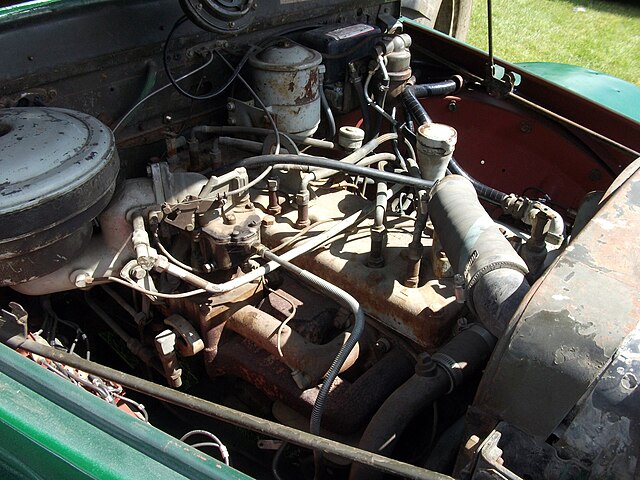 M37 Chrysler engine
M37 Chrysler engine
The T245 Dodge "L" Head, 6 cylinder engine was rated for 78 bhp (58.2 kW) at 3200 rpm. It displaced 230 cubic inches (3.8 L). The Canadian version was even a larger 250.6 cu in (4.1 L) engine. Bore: 3+1⁄4 in (82.6 mm), Stroke 4+5⁄8 in (117 mm), Oil capacity 6 U.S. quarts (5.7 L). The Radiator was of 24 L capacity. It had a Carter carburetor Model ETW-1 wih downdraft.
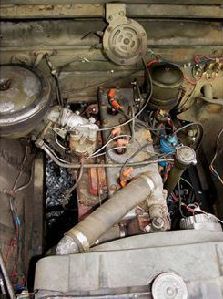
The M37 B1 had a Clutch of the Borg & Beck Model 11828 10 in (250 mm) single plate dry disc (Borg & Beck 11 inch Canada). The Transmission was modernized to a New Process Model 88950 (or NP420), in Canada replaced y the Acme Model T-98. It was 4-speed, Synchro-Shift in 3rd and 4th gear. The Transfer Case was a New Process 88845 (or NP200) with High 1:1, low 1.96:1 ratios, twin lever operation, for selection of 4×4 or 4×2 drives, hi or low range. The Drive Shaft was an MFG Universal Products with Dodge Full Floating (hypoid) axles with a ratio of 5.83:1 and front Universal Drive New Process (Tracta joint).
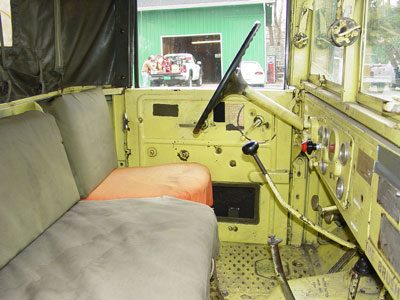
Fuel distribution comprised a single 24 U.S. gallons (91 L; 20 imp gal) tank vented through engine air intake for fording purposes. Electric starter with ignition and lights rated at 24 volts. There were Wagner hydraulic drum drums and a parking—external contracting band braking, 48 square inches (310 cm2). The Steering used a Gemmer Model B-60, worm and sector type.
Standard Wheelbase for the former Cargo Model M37 and Command Model M42 was 112 in (2.8 m) but the M43 Ambulance as well as the Telephone Maintenance vehicles Model V41 were long wheelbase models (LWB) at 126 in (3.2 m). The basic M37 without winch weighted 5,687 lb (2,580 kg), and with with winch 5,987 lb (2,716 kg). It used 9.00 × 16 - 8 ply non-directional military tyres. When equipped, these had a Braden LU-4, PTO operated winch, 7,500 lb (3,400 kg) capacity (250’ of 7/16" wire rope [75 m by 11 mm] and 10’ or 3 m chain with hook.
Specs Dodge M37 (1951) |
| Dimensions (L-w-h) | 15 ft 10 in x 6 ft 2 in x 7 ft 5 in (4.83 x 1.88 x 2.26 m) |
| Wheelbase | SWB and LWB (see variants) |
| Empty weight | 5,917 lb (2,684 kg) |
| Crew | 1 driver, +7 passengers |
| Propulsion | Dodge T-245 78 hp (58 kW) |
| Transmission | 4 speed X 2 range |
| Suspensions | Live beam axles on leaf springs |
| Top speed | 55 mph (89 km/h) |
| Maximum range | 225 mi (362 km) |
Variants & succession
Variants
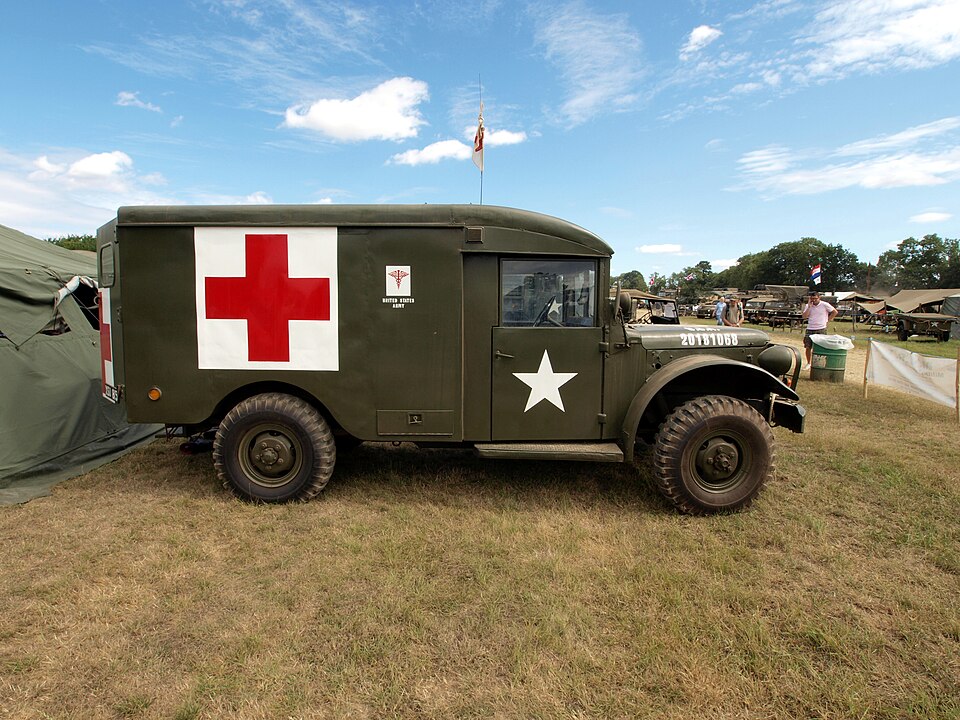 M43 Ambulance, LWB
M43 Ambulance, LWB
- M42 command truck
- M43 ambulance
- M53 cab-chassis
- M56 tool truck, has a bumper-mounted winch
- MB2 Fire and Rescue Truck (M56 with Gichner body)
- R2 air field rescue truck (w/winch)
- M152 modified enclosed utility truck, Canadian variant
- M201/V41 telephone maintenance vehicle
- M283 Long Wheel Base (LWB) Cargo Truck
- M506 truck, hydrogen peroxide servicer, PGM-11 Redstone
- V126 truck – for AN/MPX-7 radar
- XM142 experimental bomb service truck
- XM152 experimental enclosed utility truck used in small numbers by the USAF
- XM195 experimental lighter, compact version of M37
- XM708 experimental dump truck used mostly by airborne units
- XM711 experimental wrecker truck
Dodge M37/M37B1/M43 users
 Spanish Camioneta Dodge Modello 37
Spanish Camioneta Dodge Modello 37

c110,000 1951-78.

4500 vehicles, used until 1980. One variant with ATGMs.

Ejercito de Espana: Acquired 1970s.

Hellenic Army (also air force and Navy), active duntil the 1980s

Bolivia (unknown)

Guatemala (unknown)

Used by Contras 1980s

Laos (captured from Vietnam)

Cambodge (captured from Vietnam)
Combat Service
The M37 was ready in numbers already to be battle tested in Korea. Although the WV series were still abundant, there were c20,000 M37 deployed in 1950-54, enough to generate report over the points that were sticking and positive ones. On the positive side (there were many), the commonality with the Dodge WC series was a bonanza for the maintenance supply and logistics in general. They could be repaired using the very same supply lines well experienced in WW2 and transposed to the Korean theater. The vehicle was even more rugged, had better climbing abilities and a revise, slightly lighter and better thought layout, flatbed. The only issue was its use of an antiquated powerplant, great for precisely the off-road issues met in Korea, a mountaineous terrain without many good roads. It felt at home and proved adaptable.
Next it was deployed in numbers in Vietnam from 1965 onwards, coniciding with the new B1 standard (by the time, it was preferred to the now worn out WC still in service). Production indeed ended just before the têt offensive, in 1968. There, again, it was praised for the same off-road qualitioes, but since the road network was a bit better, it was found way too slow. Foe youngsters that never drove the WC series before it looked also antiquated, without creature comfort that already were mainstream in civilian cars by the 1960s.
It was deployed in many versions and found useful, still, and man ended in a new role typical of Vietnam, as "gun trucks". Just like some Jeeps and M35 general purpose trucks, many were up-armoured to supply the frontline via possible enemy ambushes along the way. The more current transformation as limited to weld side plating (not hardened, regular workshop stock steel plating) to protect the rear flatbed and install pintle mounts for M60, M1919A4 or M2HB machine guns or mortar. The forward cabin was left as is, either with hard top or soft top. In some case, add-on armour was added (see profiles below).
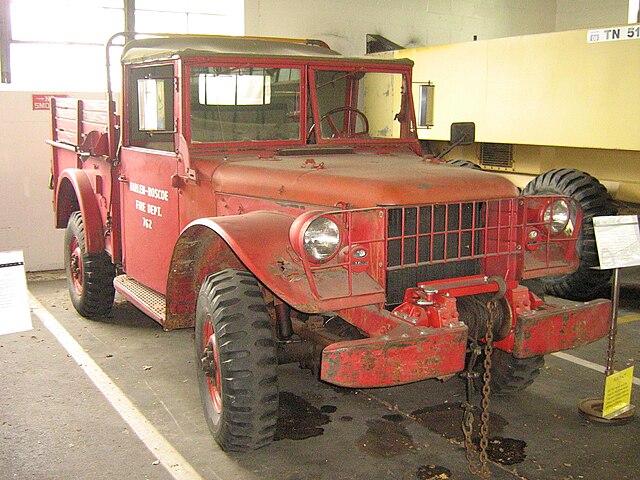 1970s Fire Truck former M56 tool truck with bumper winch
1970s Fire Truck former M56 tool truck with bumper winch
The post-vietnam years saw a replacement program that was curtailed by the Congress for off-the shelf vehicles loosely adapted to military use (COTS) and many veteran drivers regretted their rugged, militarey grade all the way Dodge M37 and WCs. The vehicles started to be replaced from 1975, proposed on the export market, delivered in large quantities to Greece, Spain, greatest users of the B1 in the late 1970s-1990s. Most were from national guard stocks. In 1978 the last of the latter had been sold to the public services in need to replace their own stock WW2 jeeps and WCs, and on the civilian market. The M37 was kept by the ARVN (South Vietnamese) and took part in the last fights until the fall of Saigon in 1975. They saw action in the Laotian Civil War, and Cambodian Civil War. They also were exported to South America and saw action in the Nicaraguan Revolution, Salvadoran Civil War and Guatemalan Civil War.
It was a popular, super-rugged pickup-truck especially in mountaineous regions difficult to access, the same in Canada. They were also were popular replacement for WCs as props in war movies and for reenacters since they were very close in appearance, without being so old. Many are still used as such today.
Succession Attempts
In the late 1960s a competition was held by the Army, to all US automotive companies for proposals to replace the M37, wich tecnology ent back to 1936 for some elements. This also condemned the whole supply chain maintainince the WC series as well. The Army to start anew. Several prototype went to preliminary examination, leading the ecceptations of the General Motors XM705 11⁄4-ton Truck, derivative XM737 Ambulance, instead of the COTS M715 series, which were not militarized enough. But the Congress cut funds for this program and the army had to make due with the COTS M715.
The XM705 had a Chevrolet 8-307 rated for 200hp at 4,600 rpm, 140hp at 4.000 rpm net. It could climb a 31.2% slope with towed load in 4th gear. Range was 300 miles, top speed 41 kph, ground pressure 128 kg/m2, ground clearance 11.8 inches. The adopted M715 had a Kaiser Jeep 6-230 engine rated for 132.5 at 4,600 rpm and 116hp at 4,000 rpm, 41 kph, 225 miles range, 16.1 Ib ground pressure.